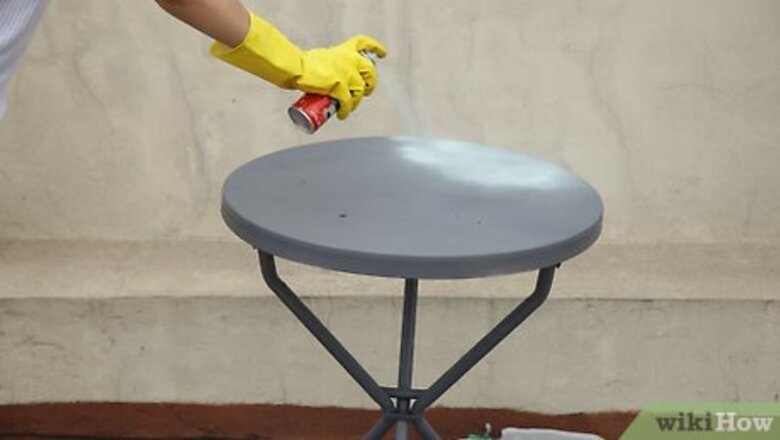
views
Protecting Your Workspace
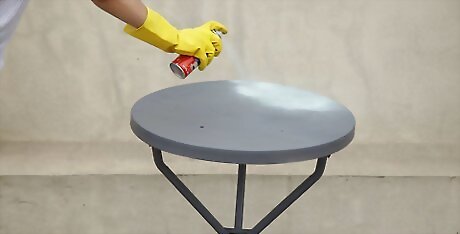
Take the project outside if possible. Spray paint is dangerous to inhale, and the overspray and dust can easily land on nearby surfaces. Take the item you want to spray paint outside when possible, such as when the temperature is mild, when there's no precipitation, and when it’s a calm day. The ideal temperature range for spray painting is between 64 and 77 F (18 and 25 C). The ideal humidity for spray painting is between 40 and 50 percent. Even if you're painting outdoors, pick a shady spot, if possible. If you paint in direct sunlight, the paint might dry too quickly, which can cause it to peel. When you can’t spray paint outside, take the project to a shed or garage if possible.

Ventilate indoor areas. Inhaling spray paint is bad for your health. To protect yourself, open windows, doors, and turn on exhaust vents when you must work inside. Don’t turn on any fans, as these will just blow the paint around. Invest in an activated carbon mask if you work with spray paint often. This will protect your lungs and keep you safe from the health problems associated with spray paint exposure.

Make a DIY spray paint booth. A spray paint booth protects surrounding areas from overspray, and protects the painted item from dust and dirt when it’s still wet. For smaller projects, you can make your own simple spray paint booth with a box and a pair of scissors: Find a box that’s larger than the items you're spray painting Cut off the flaps that form the lid Lay the box on its side with the opening facing you Cut off the top panel Leave the bottom, side, and back panels of the box in place Place the item in the center of the bottom panel
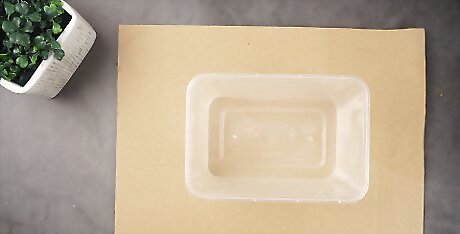
Cover surrounding areas. For larger projects, you may not be able to make your own spray paint booth. To protect the floor and surrounding areas from overspray, lay out a large drop cloth or piece of cardboard. Place the item in the center of the cloth or cardboard. If you also want to protect the drop cloth from excess paint, lay down some newspaper over the cloth and place the item on the newspaper. If you're painting outdoors on a windy day, keep in mind that the overspray could travel and get onto other surfaces.
Cleaning and Sanding the Surface
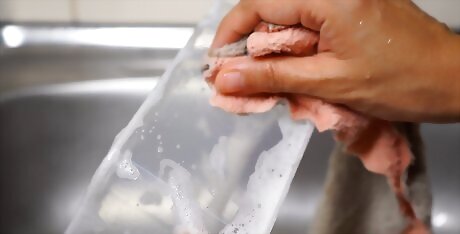
Clean the plastic. For small items, fill a sink with warm water and add a teaspoon (5 ml) of liquid dish soap. Wash the item in the sink using a cloth. For larger items, fill a bucket with soap and water. Soak a sponge or cloth in the soapy water and use the sponge to clean the item. Cleaning is a must before you paint any surface, because it will remove dust, dirt, and other particles that could prevent the paint from adhering.
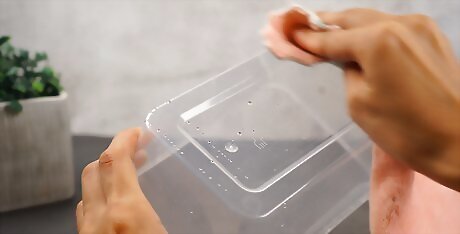
Rinse and dry the item. After cleaning, rinse the item with clean water to remove dirt and soap residue. Pat the item dry with a towel or cloth to absorb excess water. Leave the item to air dry for at least 10 minutes, or until all the water has evaporated.
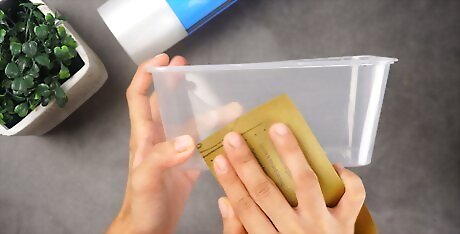
Sand the surface. When the item is completely dry, use 120-grit sandpaper to scuff the entire surface of the plastic. Sanding will rough up the surface slightly, and this will give the paint something to stick to. Sanding is especially important if the item you're painting was previously painted. Remove as much of the original paint as possible with the sandpaper.
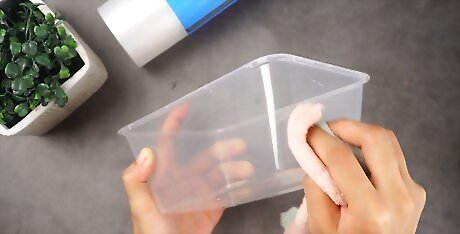
Wipe the surface. Use a microfiber, lint-free, or tack cloth to wipe down the plastic. This will remove dirt, dust, and plastic particles from sanding. Leftover dust and other debris on the surface will prevent the paint from sticking to the surface, because the paint will land on the dust particles rather than the plastic.
Applying the Paint
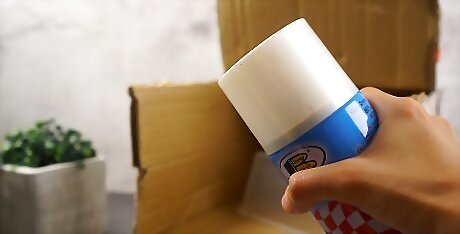
Choose the right paint. Different materials require different types of paint, and plastic typically needs a special type of spray paint. The wrong type of paint may blister, bubble, flake, or just won’t adhere properly to the surface. Look for spray paints that are specifically formulated for plastic surfaces, or that are suitable for plastics. Companies that make spray paint for plastic include Krylon, Valspar, and Rustoleum.
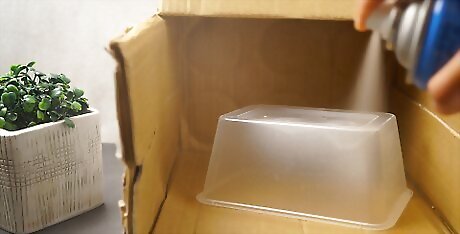
Apply a coat of paint. Shake the can of spray paint. Hold the can 12 to 18 inches (30 to 46 cm) from the object. Aim the nozzle at the object and press down. As you spray, sweep the can back and forth over the object in a vertical or horizontal motion to apply a thin and even coat to the surface. Avoid pointing the nozzle directly, at a single spot, as this will make for an uneven application. Instead, keep the can in motion as you spray.
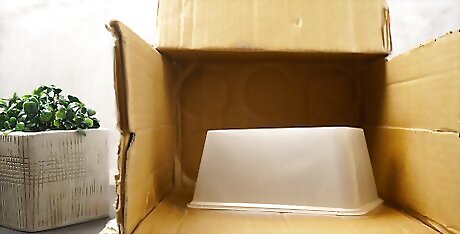
Let the coat dry. Spray paint typically requires anywhere from eight to 30 minutes to dry. After applying the first coat, let the paint dry before applying a second coat, or before turning the item over to paint the other side. Consult the manufacturer’s directions on the can for exact drying times with the paint you're using.
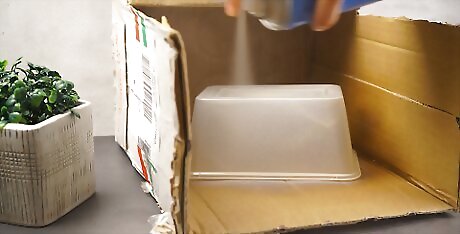
Apply a second coat. Most items will benefit from at least two coats of spray paint. When the first coat has had time to dry, apply a second coat. Use the same side to side or up and down sweeping motion as you spray to ensure a thin and even coat. When the second coat has been applied, give the paint up to 30 minutes to dry before assessing whether it needs another coat, or before painting the other side.
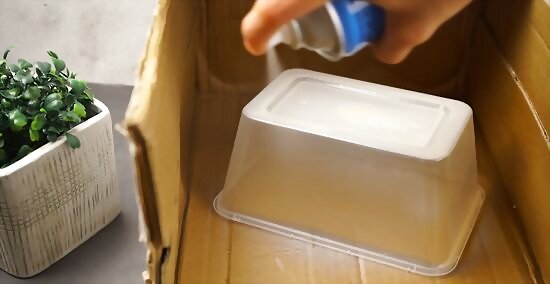
Repeat on all sides. Some objects have a bottom or other side that won’t be accessible when you're applying the initial coats of paint. When the final coat has had time to dry, turn the object over. Apply two coats of spray paint using the same technique, giving the paint up to 30 minutes to dry between coats.
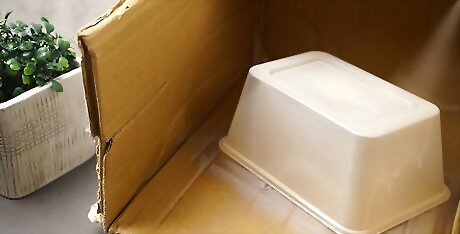
Let the paint cure. Paint generally has a drying time and a curing time. While spray paint dries in about 30 minutes, it needs about three hours to cure. Once you’ve applied the final coat of spray paint, let the item dry for at least three hours before using it normally again. With spray painted furniture, for instance, don’t sit in the chair as soon as it’s dry. Instead, wait a few hours so the paint can fully cure. The drying time is how long it takes for the paint to be dry to the touch. The curing time, on the other hand, is how long it takes for the paint molecules to fully bond and harden.
















Comments
0 comment